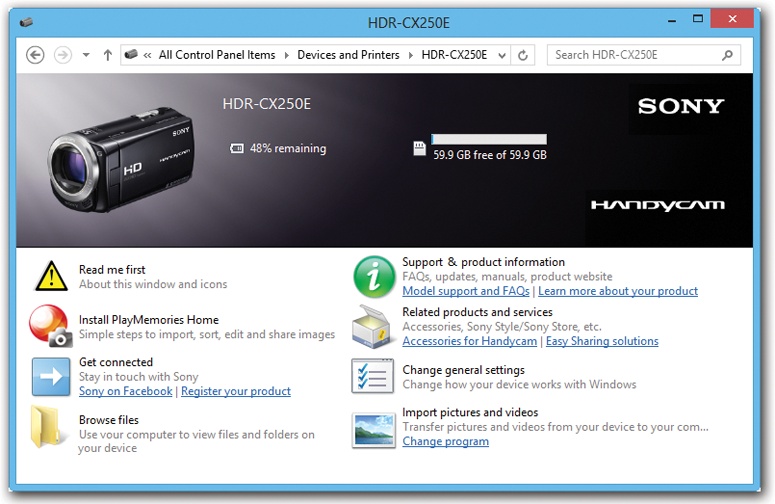The Device Stage, a feature introduced in Windows 7, is supposed to demystify the sometimes baffling world of external gadgets. Its mission: to depict, in visual form, Windows’ understanding of whatever gadgets you’ve connected to it.
Microsoft refers to Device Stage as a “home page” for the most popular kinds of gadgets: cellphones, music players, cameras, printers, scanners, multifunction printers, mice, and keyboards. They can be connected to your PC by a USB cable or even a wireless Bluetooth or WiFi connection. To open a gadget’s Device Stage window, you double-click its icon in the Devices and Printers window.
For each gadget, the Device Stage window (Figure 20-3) is supposed to display highly specific information and links. For a camera, you might see a handsome photo of the camera model you’ve plugged in, the number of photos on it to be downloaded, how much space remains on the card, and the current battery level—and you’re offered links to import the photos, read the manual, buy accessories, and so on.
For a printer, you might see ink-level details, options to buy paper and ink online, and so on; for a cellphone, you see options to edit or buy ringtones, sync with your Windows address book and calendar, and so on. For any kind of gadget, you probably get a link to the manufacturer’s Web site, too.
Microsoft doesn’t create these little model-specific pages; the gadget manufacturers are supposed to do it and submit them to Microsoft. When you attach the device to your PC, you see its own custom Device Stage page.
Now, the bad news: Very few gadgets do have Device Stage information built in. Most gadgets—including the several trillion pre-Windows 7 models—produce either no Device Stage at all, or, sometimes a generic one. This “baseline” page may offer the basic tasks—import pictures from a camera, for example—but doesn’t offer the photo and functions of your exact model.
Note
When the hardware makers get around to it, they’ll update their Device Stage screens, or add them to gizmos that are currently showing you only the generic pages. You’ll know when an updated Device Stage is available, because the top of the window will sprout a little banner inviting you to download it.
